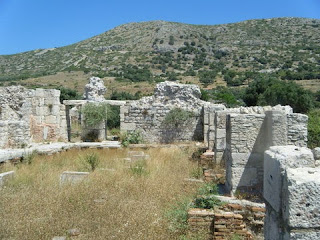by Alec Newell

The present day port town of Pithagorio (emphasis on the
third syllable), named for Samos’ favorite native son Pythagoras, is a
natural harbor that is an anchorage for a small fleet of traditional Greek
fishing boats, and a mooring place for a quarter mile row of large sailboats
and yachts. They all lie parallel to one
another with their transoms all backed neatly up to the stone wharf which rims
the town’s lower edge at its’ closest point to the water. It looks like a smaller version of the French
Riviera, with international yachtsmen and their guests sipping drinks in the
afternoon.
The wide wharf is in turn, ringed with a long row of outdoor bars and cafés, shaded by pergolas or large canvas awnings, and landscaped with large potted plants and flowering vines that cling to the sides of their walls. This very place would have been a major commercial port in ancient times, a shipping point for sending large amphorae of Greek wine back to Rome. It would also have been the logical place to have parked Cleopatra’s fleet, but I can find no historical source to confirm that.
The wide wharf is in turn, ringed with a long row of outdoor bars and cafés, shaded by pergolas or large canvas awnings, and landscaped with large potted plants and flowering vines that cling to the sides of their walls. This very place would have been a major commercial port in ancient times, a shipping point for sending large amphorae of Greek wine back to Rome. It would also have been the logical place to have parked Cleopatra’s fleet, but I can find no historical source to confirm that.
 Fanning out from the wharf like spokes from a wheel’s hub,
are narrow little stone streets lined with gift shops, more cafes, and travel
agents’ shops which specialize in booking ferry hops to Turkey and or other
neighboring Greek Islands. The western
skyline of the harbor is dominated by an 19th century citadel, and
beyond that lie several miles of a vast open plain that is bordered by a beach
on one side and by rising mountains to the North. The plain is strewn with the ruins of an
ancient roman bath
Fanning out from the wharf like spokes from a wheel’s hub,
are narrow little stone streets lined with gift shops, more cafes, and travel
agents’ shops which specialize in booking ferry hops to Turkey and or other
neighboring Greek Islands. The western
skyline of the harbor is dominated by an 19th century citadel, and
beyond that lie several miles of a vast open plain that is bordered by a beach
on one side and by rising mountains to the North. The plain is strewn with the ruins of an
ancient roman bath in which Anthony and Cleopatra
may have frolicked. Parts of the mosaic tiled floors and hollow heating chambers are still visible through the weeds. Before it became a bath, it had been an outdoor gymnasium in Hellenistic times. There is small tourist pension operating on the beach there now, with bright yellow beach umbrellas and outdoor furniture, but not much else.
Directly above the ruins, half way up the mountain, is the famed tunnel of Eupalinos, it was chiseled by hand through a mountain of solid rock for a length of 11.33 football fields, to bring water from a spring on the north side of the island to Pythagorio, which had no water. It was built more than 500 years before Anthony and Cleopatra’s arrival and was already one of the Seven Wonders of the Ancient World. If you look closely from the road, you can still see remnants of the aqueduct leading from the tunnel, down the mountain, and to the ruins below. It had been a convenient water source for the conquering Romans who had built their baths there much later. The tunnel had been documented by Herodotus in the 5th century B.C., but its’ exact location had been lost to time until it was rediscovered and cleared out in the 1880’s. Today tourists pay 5 Euros each to go down inside it for a look, but unless you’ve got a burning desire to see it, I’d save the 5 Euros.
 Looking up from the harbor below, if you could Photoshop out
the buildings, the skyline would still be instantly recognizable to an
ancient traveler entering the harbor today.
The mountain ranges haven’t changed and the grape vines that cling to
the terraced hillsides are still producing the same wine that Anthony drank
millenniums ago. Descending from the
mountain is a high road that leads from Vathi to Pithagorio, you can look down
from it and see the unchanged shape of the harbor below. I have wished at times, that I owned a time
machine that could be dialed back in time to a Spring day in 32 B.C. and that
I could cling there, like a fly on the wall, to the side of the mountain, and
watch.
Looking up from the harbor below, if you could Photoshop out
the buildings, the skyline would still be instantly recognizable to an
ancient traveler entering the harbor today.
The mountain ranges haven’t changed and the grape vines that cling to
the terraced hillsides are still producing the same wine that Anthony drank
millenniums ago. Descending from the
mountain is a high road that leads from Vathi to Pithagorio, you can look down
from it and see the unchanged shape of the harbor below. I have wished at times, that I owned a time
machine that could be dialed back in time to a Spring day in 32 B.C. and that
I could cling there, like a fly on the wall, to the side of the mountain, and
watch.









No comments:
Post a Comment